Now in Argentina, almost 30 years after atrocious human rights crimes
were committed, we have human rights trials going on which the practice
of enforced disappearances is concretely investigated and perpetrators
are brought before the courts. While other Latin American countries
which went through similar experiences in the seventies and eighties,
have preferred the road of national reconciliation, Argentina is at the
forefront in prosecuting perpetrators and provides an interesting case
study and a cause for hope among human rights activists around the
world.
Background
Argentina is known as the world’s granary because of
its immense natural resources but really is on the margin of world
affairs in the Southern Hemisphere despite its strongly European
population, unlike Australia and New Zealand in Asia Pacific. However,
it really is not different from other Latin American countries where a
small oligarchic group came to own most of its wealth that was
forcefully taken from the native peoples in Spanish colonial times. Even
after the final extermination campaigns of native Argentines were ended
in the Patagonia and the Tropical north, towards the end of the XIX
century, that land was handed over to the traditional elite, and the
immigrant population had no option but to stay in the cities. The
country was destined to produce and export raw materials but not to
industrialize or manufacture any goods. There were several attempts to
break this deadlock through industrialization, the most famous being the
government of Juan Domingo Peron and his charismatic wife Eva in the
late 1940s, but all ended with military coups and repression. Then in
the sixties, Argentine youth, inspired by Che Guevara and other
revolutionaries, many within the Peronist movement, organized to produce
the social change that was needed to overcome longstanding structural
violence. This way of revolutionary struggle was met by the violence of
the State now known as ‘State terrorism’ which reached its pinnacle with
the Junta Dictatorship (1976 – 83). The cornerstone of State terrorism
was the practice of enforced disappearance, but it took many years
before the full dimension of what was clandestinely going on was finally
brought to the public light. The key players were the families of the
disappeared, especially the Madres of Plaza de Mayo.
Why such a strong sentiment for justice in Argentina?
Certain events in recent Argentine history may
explain the strong national sentiment towards justice.
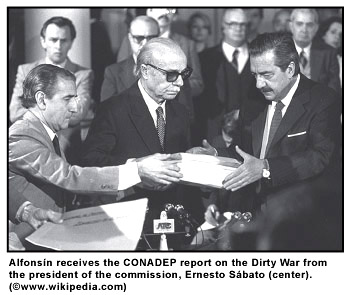 The
first and most important element is the nature of the crime involved,
i.e., enforced disappearance. Here, official cynicism was the order of
the day as the demand to know the whereabouts of a loved one was
routinely dismissed by the authorities, or relatives of the victim were
blackmailed into giving money and property for information which
effectively always proved to be without substance. Then relatives
themselves became victims. This situation went on for many years and
created such a deeply-rooted sentiment of resentment towards impunity
that exasperates itself with the passage of time.
The
first and most important element is the nature of the crime involved,
i.e., enforced disappearance. Here, official cynicism was the order of
the day as the demand to know the whereabouts of a loved one was
routinely dismissed by the authorities, or relatives of the victim were
blackmailed into giving money and property for information which
effectively always proved to be without substance. Then relatives
themselves became victims. This situation went on for many years and
created such a deeply-rooted sentiment of resentment towards impunity
that exasperates itself with the passage of time.
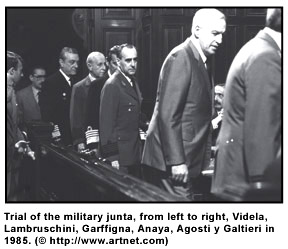 The
second reason is that when the dictatorship was nearing its end, it
decided in 1982 to initiate a patriotic war against the UK in order to
recover sovereignty over the Falkland (Malvinas) Islands and to recover
prestige. However, there were many losses. Argentina lost the war and
people felt totally betrayed by the military. Since then, the Armed
Forces lost their status in society. There is therefore, little sympathy
when former senior officers are brought into courts.
The
second reason is that when the dictatorship was nearing its end, it
decided in 1982 to initiate a patriotic war against the UK in order to
recover sovereignty over the Falkland (Malvinas) Islands and to recover
prestige. However, there were many losses. Argentina lost the war and
people felt totally betrayed by the military. Since then, the Armed
Forces lost their status in society. There is therefore, little sympathy
when former senior officers are brought into courts.
From Human Rights Crimes to Impunity to Justice
1984: The CONADEP Commission - After the
late President Raul Alfonsin became democratic president at the end of
1983, this presidential commission was appointed to investigate the case
of the desaparecidos. The result was the "Never Again"
report presented by writer Ernesto Sabato, which fully documented
the enforced disappearances with the different circuits of secret
detention centers, clandestine cemeteries and military task forces.
1985: The Argentine Junta Trial - For the first
time ever in Latin America, top military leaders, the Junta were charged
before a civilian court and condemned to long sentences of imprisonment
for multiple human rights violations, above all, the enforced
disappearances. Due to the nature of the crimes involved, the Court
recommended the prosecution of all perpetrators down the line of
command.
1986 First Impunity Law - Final Point Law The
military mobilized against those prosecutions and President Alfonsín
gave in. A law was approved at the end of 1986 which gave a deadline for
presenting new human rights cases. The immediate result was that
hundreds of new cases were rushed into the courts to meet that deadline
and many more military people were implicated.
1987 Second Impunity Law - Due Obedience Law The
military began to openly rebel against the prosecutions, and to occupy
military establishments in defiance of the democratic government.
Finally, President Alfonsin negotiated and the Due Obedience Law was
passed by Congress. That meant that only the top command structure could
be charged for human rights violations and all the other cases had to be
dropped. There was an exception – the case of disappeared children.
1990 Third Impunity Measures - Presidential Pardons. The new
President Carlos Menem (1989 -1990) decided on a pacification process
where reparation would be given to victims but penal prosecutions would
be discontinued. There were a series of presidential pardons granted so
that by the end of 1991, even those sentenced in the Junta Trials, were
released.
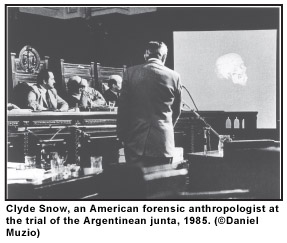
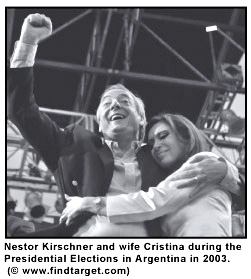
1992 Argentine Trials in Europe and Universal
Jurisdiction.
With impunity reigning in the county, families and
the human rights organizations began to promote trials in European
countries whose citizens had been victims of the Argentine dictatorship.
As there was no possibility of prosecution in Argentina, those penal
processes had become perfectly legal. So cases were opened in Sweden,
France, Italy, Germany and above all Spain where Judge Baltasar Garzon
began to also use the argument of universal jurisdiction whenever crimes
against humanity were involved. According to universal jurisdiction,
when impunity exists for a crime against humanity in a specific country,
any other country can claim jurisdiction to prosecute perpetrators.
Enforced disappearance is a crime against humanity. This led to Judge
Garzon issuing an arrest warrant in 1994 against former Chilean dictator
Augusto Pinochet who was visiting London. Pinochet was arrested and
returned to Chile on humanitarian grounds. However, the UK House of
Lords had recognized the Garzon petition as valid. Many new arrest
warrants were issued against Argentine perpetrators so much that towards
the end of the ninetees, none could safely leave the country. However
the Menem government absolutely refused to extradite any military
officer to Spain. Simultaneously both the Inter American Human Rights
Commission and Court intervened and ruled that the Argentine impunity
laws went against the principles of international law.
Prosecutions for the Disappeared Children Continue
In Argentina, the cases for the disappeared children
could however, continue and it was successfully argued in court that
such a practice had in fact been endorsed at the top command structure
of the Armed Forces. In that way the Junta leaders found themselves back
in prison under new charges.
Triumph of the Anti-Impunity Movement
Between 2000 and 2003, Argentina went through a
period of total economic collapse. Finally in 2003, Mr. Nestor Kirchner
was elected President. He surprised many by taking a very strong pro
human rights position and among other measures began to argue for the
absolute nullity of the impunity laws and for the continuation of the
human rights trials which had been halted in 1987. Finally, the military
accepted that policy as they preferred to be prosecuted in Argentina
rather than extradited to Spain. Meanwhile President Kirchner achieved
an important reform of the Supreme Court. A law was approved by Congress
nullifying all the impunity laws, and in a historic decision in 2005,
the Supreme Court certified their absolute nullity. The human rights
trials were reinitiated.
How do the human rights trials work?
To begin with in these trials, those who have been
personally affected by the crimes involved can participate as part of
the prosecution. That means that victims are directly involved. Many
human rights organizations have recruited young lawyers to work in the
courtrooms to represent the victims. According to the Argentine judicial
system, there are two stages in the penal process. The Instruction
stage is when a specific crime is investigated, perpetrators are
identified and written testimonies taken from witnesses. All parts
intervene and defendants may be imprisoned. A special prison was opened
in Marcos Paz, Buenos Aires Province where perpetrators of human rights
violations are held. Those who are older than seventy can be allowed the
benefit of home arrest. This is also granted to those with serious
health problems and some argue senility to avoid prosecution.
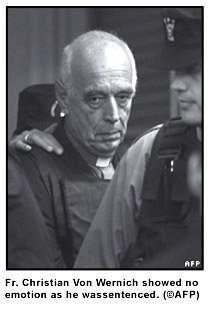 The
Instruction finishes with the formal accusation which is handed over to
a Federal Court where the Public and Oral trial takes place. This
is the second and final stage which usually goes for several months.
This process opens with the formal indictment of the defendants who must
appear in court. It is then when families can see them for the first
time. Then witnesses are called in to give their testimony and answer
questions both of the prosecution (including representatives of the
victims) and the defense. Forensic or other experts address the court
and the defense may also call other witnesses. Finally there is the
summing up of the parts. On the last day of the public hearings, the
defendants are allowed to make their final statement and then the judges
(usually three) give their verdict. About two weeks afterwards, the
court is convened again when the full sentence is out. Finally the
entire proceedings automatically go for review to the higher Cassation
Court which makes a final legal ruling on the proceedings. That
may take a year or more. The case can then be appealed to the Supreme
Court but that has rarely, if at all, happened.
The
Instruction finishes with the formal accusation which is handed over to
a Federal Court where the Public and Oral trial takes place. This
is the second and final stage which usually goes for several months.
This process opens with the formal indictment of the defendants who must
appear in court. It is then when families can see them for the first
time. Then witnesses are called in to give their testimony and answer
questions both of the prosecution (including representatives of the
victims) and the defense. Forensic or other experts address the court
and the defense may also call other witnesses. Finally there is the
summing up of the parts. On the last day of the public hearings, the
defendants are allowed to make their final statement and then the judges
(usually three) give their verdict. About two weeks afterwards, the
court is convened again when the full sentence is out. Finally the
entire proceedings automatically go for review to the higher Cassation
Court which makes a final legal ruling on the proceedings. That
may take a year or more. The case can then be appealed to the Supreme
Court but that has rarely, if at all, happened.
The cases involved refer to very specific crimes in
the penal code such as homicide, illegal arrest, torture etc. (enforced
disappearance or genocide is not listed). For a guilty verdict, criminal
responsibility has to be proved beyond doubt. If not, the defendant will
be acquitted. The sessions are public so anyone can attend the hearings
and sometimes the media are allowed in, but in most cases, there are
restrictions. It all depends on the court.
To facilitate the process, cases are divided
according to the five military divisions of Argentina applied during the
dictatorship. Usually cases are identified and grouped with specific
secret detentions centers. Some secret detention centers are so big that
the category of "mega cases" had to be created. These mega cases are
sometimes divided down for trial purposes.
Completed Cases:
The following list of completed cases shows how the
process is working:
2006: Buenos Aires: Former Federal police officer
Julio Hector Simon was condemned for several human rights crimes.
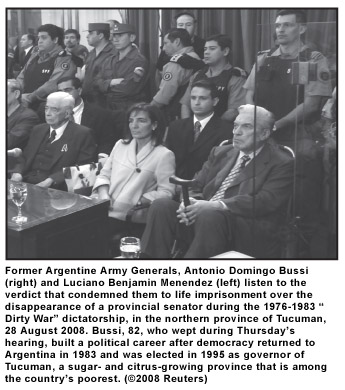 2007:
La Plata: Miguel Etchcolatz , former head of the secret police in
the Province of Buenos Aires was condemned for 5 cases of homicide and
torture. It was during his trial that an important witness, Julio Jorge
Lopez (73), was disappeared and has never been heard of since. There is
evidence that former police were involved. This incident highlights the
risks facing witnesses and many other cases of harassment have been
reported, although a witness protection program is now in place.
2007:
La Plata: Miguel Etchcolatz , former head of the secret police in
the Province of Buenos Aires was condemned for 5 cases of homicide and
torture. It was during his trial that an important witness, Julio Jorge
Lopez (73), was disappeared and has never been heard of since. There is
evidence that former police were involved. This incident highlights the
risks facing witnesses and many other cases of harassment have been
reported, although a witness protection program is now in place.
2008: La Plata: Roman Catholic priest Fr.
Christian Von Wernich, police chaplain during the dictatorship, was
condemned for his role in the disappearance and assassination of a group
of young people during the dictatorship. Despite the scandal involved,
the Church has not sanctioned the priest who continues to minister to
his fellow prisoners in Marcos Paz prison.
2008: Buenos Aires: The Fatima Massacre. That was
the mass killing of thirty prisoners mostly trade union activists taken
from a secret detention center in August 1976 and assassinated in
Fatima, a small rural community near Buenos Aires. One of the defendants
was acquitted on a medical alibi, the others were condemned.
2008: Tucuman: Former generals Domingo Bussi and
Benjamin Menendez were condemned to life imprisonment for their role in
the disappearance of senator Vargas Aignasse in 1976.
2009: Buenos Aires Province: Gral Olivera
Rovere and other ranking officers were condemned for different cases but
other defendants were given light sentences or acquitted. There had been
many cases in other provinces and cities around Argentina including two
cases where military officers, who had adopted children of the
disappeared, were indicted and condemned for the crime of suppressing
the identity of those children.
Conclusion
Now many cases have completed the Instruction stage
and are at the trial process. One can say then that a characteristic of
the human rights trials in Argentina is that many are taking place in
different parts of the country and each one has its own characteristic.
The trials are certainly historic as it is the first time that families
and survivors have the opportunity of seeing perpetrators close up as
they are escorted handcuffed into the courtroom. That is a major
achievement. However, all seem unrepentant as they listen to the stories
of their cruelties and one is left is with many unanswered questions as
to their motivations and mentality.
We also hear the stories from witnesses and relatives
who go through the sufferings endured almost thirty years ago. The fact
that most are now older folk with their grandchildren listening to their
testimonies in the public gallery gives a special poignancy to the whole
situation. It is not easy to relive those situations but it is
significant that witnesses seem to remember every detail of their
traumatic experiences. Psychological assistance is offered and survivors
have organized support groups.
At the end of the day, however, all seem to be
worthwhile. There is a profound sense of achievement for witnesses and
families with a definite sense of closure. Impunity has not had the last
word. One has been able to tell one’s story in a courtroom and in front
of the perpetrators. The justice which is later handed down may be meek,
indeed considering the crimes involved but it is justice and there is a
definite sense that Never Again has become possible even with
that justice. The Argentine population is certainly privileged to be
able to finally break with impunity and live through this judicial
process. Hopefully, other countries will soon follow. That is what the
struggle of the families of the disappeared is all about: Truth,
Justice, Redress, Memory and Solidarity.

Patricio Rice was the Executive
Secretary of FEDEFAM from 1981 -1987. He is also a witness in some of
the human rights trials in Argentina.